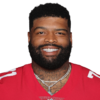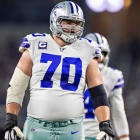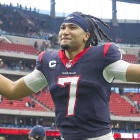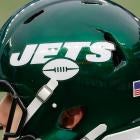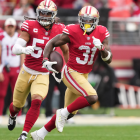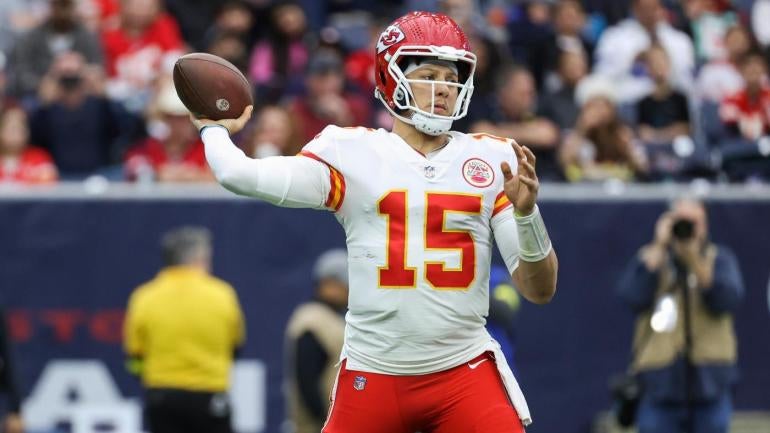
It's that time of year when not much is going on, day-to-day, in the NFL. That means we like to take stock of the teams and players and do our thing with lists and comparisons and what-have-you. Consider this another entry in that file.
We're going to compare the AFC and NFC across every positional group, and figure out which conference has the advantage. We begin today with the offensive side of the ball, and finish things up in part two with the defense.
Without further ado...
Quarterback: (Huge) Advantage AFC
Well, we know where the big advantage lies here. Just look at the names.
The AFC has (deep breath) Patrick Mahomes, Josh Allen, Joe Burrow, Lamar Jackson, Justin Herbert, Trevor Lawrence, and Tua Tagovailoa. And those are just the guys who played at any extremely high level last year. The conference also features players like Aaron Rodgers, Russell Wilson, and Deshaun Watson, who played at Pro Bowl or better levels recently but not last season, plus players like Ryan Tannehill, Jimmy Garoppolo, and Mac Jones, who have been average or better starters. And then there's second-year man Kenny Pickett, plus rookies in C.J. Stroud and Anthony Richardson. That's the whole conference.
Contrast that with the NFC, where it's Jalen Hurts and Dak Prescott, and then, uh... Geno Smith, Kirk Cousins, Jared Goff, Daniel Jones. Matthew Stafford, Kyler Murray, and Derek Carr, plus Justin Fields, Jordan Love, Desmond Ridder, Brock Purdy, Sam Howell, Bryce Young, and I guess Baker Mayfield?
It's really no contest here. Even looking at how these quarterbacks performed in 2023, AFC passers were more efficient (EPA per dropback), more accurate, took sacks less often as a percentage of overall dropbacks and pressured dropbacks despite being under pressure more often, and created more explosive plays than their NFC counterparts. Were it not for NFC quarterbacks' interception luck (39% of their potential interceptions were dropped, compared with 31.8% of them for AFC quarterbacks, per Tru Media), this might have been even more of a landslide in the passing department. Hurts and Fields helped the NFC pull ahead in the rushing statistics, while Jackson missing a significant portion of the season hurt the AFC there.
Still, we know which conference is clearly superior.
| Conference | NFC | AFC |
| EPA/dropback | 0.02 | 0.05 |
| Comp % | 65.5% | 64.4% |
| Off target % | 10.7% | 10.6% |
| Yds/att | 7.07 | 7.19 |
| TD % | 4.43% | 4.33% |
| INT % | 2.06% | 2.17% |
| % Dropped INT | 39.0% | 31.8% |
| Sack % | 6.8% | 6.3% |
| Pressure % | 32.0% | 33.3% |
| Sack/pressure | 20.4% | 18.1% |
| Scramble/pressure | 13.9% | 13.2% |
| Yds/scramble | 7.8 | 7.7 |
| 1D/att | 34.2% | 34.1% |
| Expl/DB | 7.5% | 8.4% |
| Yds/rush | 4.52 | 4.33 |
| YBCO/att | 2.22 | 2.37 |
| YCO/att | 2.31 | 1.96 |
| % No gain or loss | 28.7% | 29.1% |
| % 5+ yards | 37.4% | 37.9% |
| % Explosive | 10.7% | 10.0% |
| Avoided tackle % | 12.9% | 10.5% |
Running Back: Advantage AFC
It's admittedly tougher to make a call here than it is at other positions because so much of running back production is dependent on factors outside of the running back's actual talent. The quality of blocking matters first and foremost. The scheme and the player's fit within it play a role. The quarterback's willingness to throw the ball to his backs, either as a primary option or a checkdown, also factors in.
But we do know some areas the backs themselves have more control over: breaking tackles, yards after contact, yards after catch, and creating big plays. When comparing last year's production across multiple statistical measurements, it becomes clear that AFC backs mostly performed better in the areas where running backs make more of an impact with their own skills. The margins are pretty thin, but they did perform a bit better.
| Conference | NFC | AFC |
| Rush success % | 38.7% | 38.0% |
| Yds/att | 4.39 | 4.40 |
| YBCO/att | 1.45 | 1.38 |
| YCO/att | 2.94 | 3.02 |
| % No gain or loss | 16.9% | 18.0% |
| % 5+ yards | 35.7% | 34.8% |
| % Explosive | 7.6% | 7.7% |
| 3rd/4th + 1 conv % | 69.2% | 64.5% |
| Avoided tackle % | 16.8% | 19.8% |
| Target % | 17.6% | 19.70% |
| Yds/rec | 7.41 | 7.17 |
| Yds/rte | 1.01 | 1.08 |
| YAC/rec | 7.62 | 7.29 |
| Rec success % | 42.5% | 40.5% |
Of course, this year's backs are not the same as last year's. The NFC could be helped by, for example, Tony Pollard taking over even more of Ezekiel Elliott's workload (or Rachaad White taking Leonard Fournette's); the additions of Bijan Robinson, Jahmyr Gibbs, and Zach Charbonnet in the draft; Christian McCaffrey having a full season in San Francisco, and more. And the AFC could take a step backward if Derrick Henry starts to break down or Josh Jacobs returns to the type of player he was before his career-best season or Joe Mixon disappoints or the older backs in Miami can't recapture its 49er form, or any number of other reasons.
But if you just look at the talent and what matters in running back production, one conference has players like Nick Chubb, Austin Ekeler, Jonathan Taylor, Jacobs, Henry, Rhamondre Stevenson, Travis Etienne, Breece Hall, J.K. Dobbins... it just seems like there is more depth of high-end backs than in the conference featuring the aforementioned McCaffrey, Pollard, Robinson, and Gibbs, along with Saquon Barkley, a likely-to-be-suspended Alvin Kamara, and Kenneth Walker III, Alexander Mattison and Miles Sanders (among others).
Wide Receiver: Advantage NFC
This is an interesting one because there are probably more imposing individual wide receivers corps in the AFC than in the NFC. I'm not sure any NFC team can rival Ja'Marr Chase, Tee Higgins, and Tyler Boyd, or Tyreek Hill and Jaylen Waddle, or Keenan Allen and Mike Williams. The Eagles have A.J. Brown and DeVonta Smith, but they're the only team that comes close to matching the level of top-end duos or trios that the AFC has.
But there are also more AFC teams with sort of blah receiver corps, and the talent is just more spread out in the NFC overall. There's CeeDee Lamb, Terry McLaurin, D.J. Moore, Amon-Ra St. Brown, Justin Jefferson, Drake London, Chris Olave, Mike Evans, Chris Godwin, Cooper Kupp, Deebo Samuel, Brandon Aiyuk, DK Metcalf, and Tyler Lockett. Not to mention rookies like Jaxon Smith-Njigba and Jordan Addison, and AFC arrivals like Brandin Cooks. The AFC also has stars like Stefon Diggs, Davante Adams, Garrett Wilson, and Amari Cooper, but the depth of talent isn't there like it is in the NFC.
That's why I wasn't necessarily surprised to discover that despite AFC quarterbacks being better overall, the NFC receivers out-performed those from the AFC last season. They were targeted more often, caught a higher share of their targets, averaged more yards per route run, created more yards after the catch, had a higher success rate, and dropped the ball less often. They were flat-out better. With the talent on hand, we can expect that to continue.
| Conference | NFC | AFC |
| Target % | 19.4% | 18.4% |
| Catch % | 64.1% | 62.5% |
| Yds/rec | 12.4 | 12.8 |
| Yds/rte | 1.54 | 1.47 |
| Adj. yds/rte | 2.38 | 2.26 |
| YAC/rec | 4.39 | 4.13 |
| Air yds/tgt | 10.32 | 10.75 |
| Air conv % | 76.8% | 74.3% |
| Expl/tgt | 16.5% | 17.0% |
| 1D/tgt | 38.0% | 38.0% |
| Success % | 50.0% | 49.8% |
| Drop % | 3.8% | 4.6% |
Tight End: Advantage AFC
The AFC tight ends rather dramatically outperformed their NFC counterparts last season. They were targeted more often, averaged more yards per reception, per route, and after the catch, threatened defenses further down the field, and created explosive plays and first downs more often.
| Conference | NFC | AFC |
| Target % | 16.6% | 17.2% |
| Catch % | 69.9% | 68.4% |
| Yds/rec | 10.2 | 10.8 |
| Yds/rte | 1.18 | 1.27 |
| Adj yds/rte | 1.91 | 2.02 |
| YAC/rec | 4.97 | 5.07 |
| Air yds/tgt | 6.43 | 7.18 |
| Air conv % | 110.0% | 102.4% |
| Expl/tgt | 13.3% | 15.3% |
| 1D/tgt | 36.0% | 37.1% |
| Success % | 51.3% | 50.1% |
| Drop % | 4.4% | 4.7% |
Considering the AFC is home to Travis Kelce and Mark Andrews, that's not surprising. The NFC has George Kittle, who is an outstanding receiver who doesn't get to show it quite as often as his elite counterparts but makes up for it by being the best blocking tight end in the NFL. It also has T.J. Hockenson, Dallas Goedert, and Kyle Pitts, and technically Taysom Hill. It even has Darren Waller now, after a trade from the Raiders to the Giants.
But the AFC supplements its elite duo with David Njoku, Pat Freiermuth, and Evan Engram, plus solid players like Dawson Knox, Hunter Henry, Mike Gesicki, Tyler Conklin, and Dalton Schultz, and has young players with potential like Greg Dulcich, Chigoziem Okonkwo, Michael Mayer, and Isaiah Likely. There is just a greater depth of talent in the conference, in addition to featuring probably the two best pass-catching tight ends in the league.
Offensive Tackle: (Very Big) Advantage NFC
Amazingly, the NFC's advantage here is almost as significant as the one for the AFC at quarterback.
Pro Football Focus' top five highest-graded tackles from last season all play in the NFC. (Trent Williams, Christian Darrisaw, Andrew Thomas, Kaleb McGary, and Lane Johnson.) The NFC also has nine of the top 10, 14 of the top 20, and 21 of the top 32. The conference also had 15 of the top 20 in pass-blocking efficiency, and each of the top seven and eight of the top 10 in run-blocking grade. And all of that was with Tyron Smith -- routinely one of the NFL's best left tackles when healthy -- missing almost the entire season. Throw in development for players like Evan Neal, Braxton Jones, Zach Tom, Ickey Ekwonu, Charles Cross, and Abraham Lucas, and the conference is just incredibly heavy with top-end talent and extremely deep. (We haven't even mentioned the likes of Jordan Mailata, Penei Sewell, Ryan Ramczyk or Tristan Wirfs, not to mention Terence Steele, Taylor Decker, Brian O'Neill, Taylor Moton and more.)
The AFC has some strong talent with the likes of Laremy Tunsil, Rashawn Slater, Terron Armstead, Ronnie Stanley, the Browns' bookends of Jedrick Wills and Jack Conklin, Kolton Miller, Jawaan Taylor, Dion Dawkins, and more. But it also has a lot more question marks on both ends of the line than does the NFC.
Interior OL: Advantage AFC
The NFC might have the single-best interior offensive lineman with Zack Martin, who just keeps churning out All-Pro campaigns year after year. It might also have the best center with Jason Kelce, and it also has stars like Chris Lindstrom and emerging talents like Landon Dickerson, Jonah Jackson, Garrett Bradbury, and Teven Jenkins, among others. But it can't compete with the depth of interior talent in the AFC.
Just look at some of these teams: Cole Strange, David Andrews, and Michael Onwenu in New England. Laken Tomlinson and Alijah Vera-Tucker in New York. Joel Bitonio and Wyatt Teller in Cleveland. Quenton Nelson and Ryan Kelly (when he's healthy) in Indianapolis. Joe Thuney, Creed Humphrey, and Trey Smith in Kansas City. And that's before we get to players like Connor Williams (who had his best season after moving to center with the Dolphins), James Daniels, Shaq Mason, Ben Powers, Corey Linsley, Mitch Morse, Kevin Zeitler, Tyler Linderbaum, Ted Karras, Alex Cappa, and a whole lot more.










